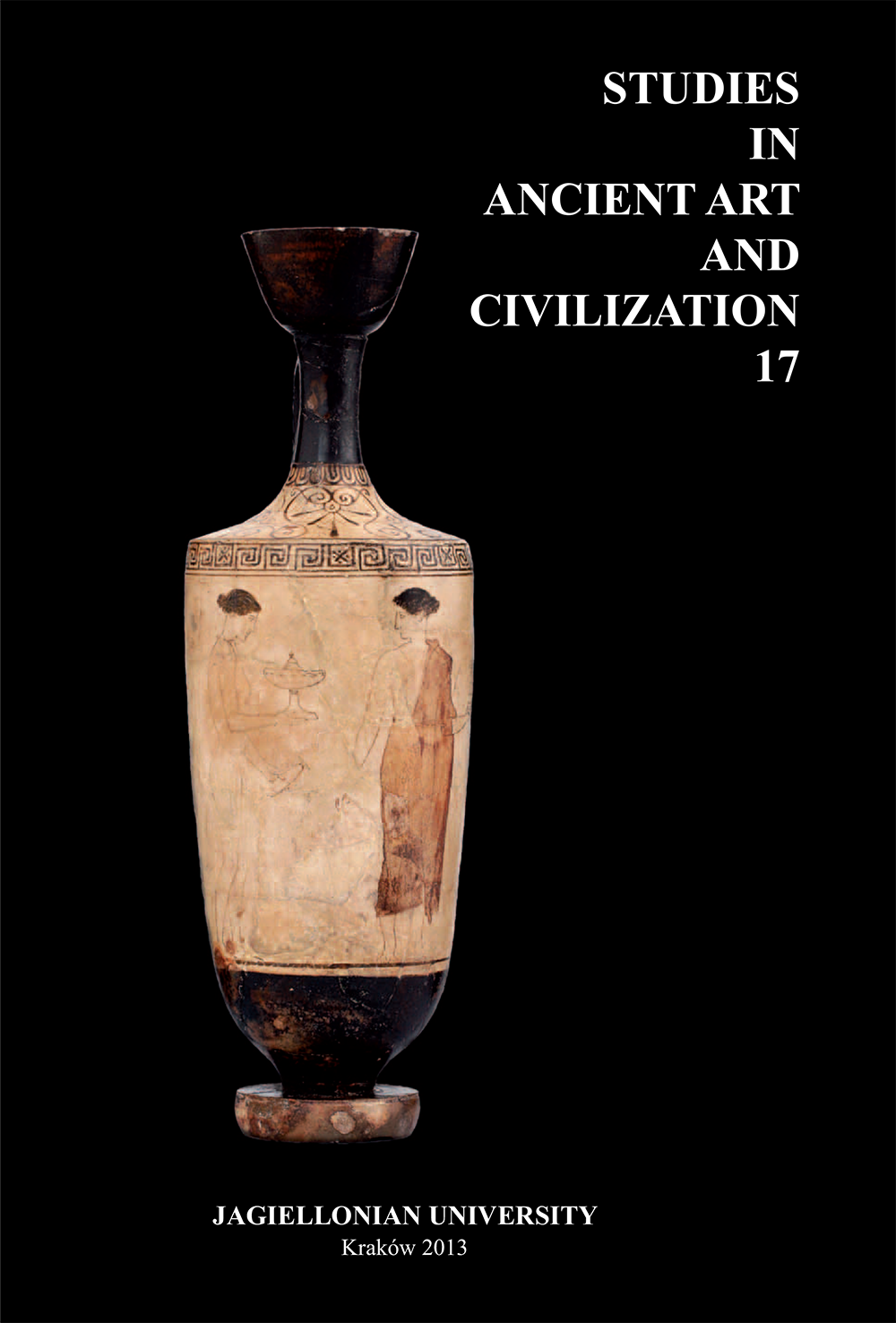Magical Amulet from Paphos with the ιαεω- Palindrome
DOI:
https://doi.org/10.12797/SAAC.17.2013.17.24Keywords:
amulets, ancient magic, Harpocrates, Osiris, palindromes, PaphosAbstract
During the first excavation campaign of the Paphos Agora Project (3rd July – 6th August 2011), an interesting object was discovered. In Trench II, Area 2 (Room 5), in the upper, late Roman layer, an oval amulet was found (siltstone, 39.41 x 41.32 x 4.81mm). The layer is dated to the 6th century AD, partially due to the presence of ceramic objects of the Cypriot Red Slip Ware type (Hayes form 2, AD 450-550). The obverse of the amulet contains a schematic, simplified figure of a sitting Harpocrates and below the mummy of Osiris in a boat, as well as depictions of animals (a crocodile, a rooster and a snake) and symbolic astrals (a half-moon and a star). On the reverse, however, an eight-line text of the so-called ιαεω- palindrome, consisting of 59 letters of the Greek alphabet, was carved. According to the current state of knowledge, it was translated in the following way: “Yahweh is the bearer of the secret name, the lion of Re secure in his shrine”. Both the depiction and the text carved into the surface of the amulet clearly indicate the influence of the Orient and the context of solar ideas; the object may be dated to the 5th-6th century AD.
References
Bonner C. 1950. Studies in Magical Amulets Chiefly Graeco-Egyptian. (University of Michigan Studies. Humanistic Series 49). Ann Arbor, London.
Brashear W. B. 1995. The Greek magical papyri: an introduction and survey; annotated bibliography (1928-1994). In ANRW 2/18.5, 3379-3684. Berlin, New York. DOI: https://doi.org/10.1515/9783110875720-013
Delatte A. and Derchain Ph. 1964. Les intailles magiques gréco-égyptiennes. Bibliothèque nationale. Cabinet des médailles et antiques. Paris.
Donnay J. 1984. Instrument divinatoire d’époque romaine. In J. Balty (ed.), Apamée de Syrie. Bilan des recherches archéologiques 1973-1979. Aspects de l’architecture domestique d’Apamée. Actes du colloque tenu à Bruxelles les 29, 30 3e 31 Mai 1980, 203-207. (Fouilles d’Apamée de Syrie. Miscellanea 13). Bruxelles.
Dziwiza K. 2011. Das “Zaubergerät” aus Pergamon. In Pergamon. Panorama der antiken Metropole, 239-241 and 542-543. Berlin.
Ganschinietz R. 1914. S.v. Iao. In RE 9, col. 700-701.
Gordon R. 2002. Another view of the Pergamon divination kit. JRA 15, 188-198. DOI: https://doi.org/10.1017/S1047759400013908
Mastrocinque A. 2002. The divinatory kit from Pergamon and Greek magic in late antiquity. JRA 15, 173-187. DOI: https://doi.org/10.1017/S1047759400013891
Mastrocinque A. 2004. Sylloge Gemmarum Gnosticarum, parte 1. (Bolletino di Numismatica. Monografia 8/2.1). Rome.
Michel S. 2001. Die Magischen Gemmen im Britischen Museum. Band 1: Text, Band 2: Tafeln und Indices. London. DOI: https://doi.org/10.1524/9783050081434.1
Michel S. 2004. Die Magischen Gemmen. Zu Bildern und Zauberformeln auf geschnittenen Steinen der Antike und Neuzeit. (Studien aus dem Warburg-Haus 7). Berlin. DOI: https://doi.org/10.1524/9783050050003
Papuci-Władyka E. 2011. Z magiczną inskrypcją w języku greckim. Paphos Agora Project – nowy projekt Instytutu Archeologii UJ na Cyprze, 16-18. Alma Mater 139.
Schmidt K. Fr. W. 1931. Review of Preisendanz 1928. Göttingische Gelehrte Anzeigen 1193, 441-458.
Schmidt K. Fr. W. 1934. Review of Preisendanz 1931. Göttingische Gelehrte Anzeigen 1196, 169-186.
Śliwa J. 1989. Egyptian scarabs and magical gems from the collection of Constantine Schmidt-Ciążyński. (Zeszyty Naukowe Uniwersytetu Jagiellońskiego 917. Prace Archeologiczne 45. Studia z Archeologii Śródziemnomorskiej 11). Warsaw, Krakow.
Spier J. 2007. Late Antique and Early Christian Gems. Wiesbaden. DOI: https://doi.org/10.29091/9783954908462
Wünsch R. 1905. Antikes Zaubergerät aus Pergamon. (Jahrbuch des Deutschen Archäologischen Instituts. Sechstes Ergänzungsheft). Berlin.
Downloads
Published
Issue
Section
How to Cite
Funding data
-
Narodowym Centrum Nauki
Grant numbers 2011/01/B/HS3/01282






